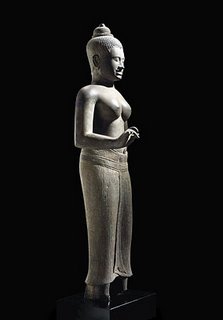How can this happen?
 This 11th-century statue in the Baphuon style fetched $2.11 million at Christie's (Photo: Sotheby's)
This 11th-century statue in the Baphuon style fetched $2.11 million at Christie's (Photo: Sotheby's)Some of the sales included the following:
A sandstone figure of a woman carved in the 11th century in the style known as Banteay Srei and described as having been acquired in 1986 was missing its head, very neatly chopped off, and both feet. It's commercial performance was not affected and it raised $361,000, nearly six times the estimate. Next, a 12th-century bronze bodhisattva from the Angkor period. No provenance at all here, no date of acquisition. The 34 centimeter four-armed statue did not sell so well, and only went under the hammer for $73,000. It was followed by a 13th-century bronze figure of Ganesha seated on a pedestal cast in the Bayon style, which exceeded its high estimate by half, climbing to $52,000. For this item the catalogue noted "Provenance. Hong Kong Collection, 1980s," implying little more than it had been in Hong Kong at some stage. This complete disregard for its Cambodian origin is blatant and grossly shameful. Two days later, at Christie's, things got a lot hotter. A Khmer statue of the 11th century in the Baphuon style had surfaced in the market in 1968, two years before the UNESCO cut-off line of 1970, after which goods of uncertain provenance are deemed less legitimate. At $2.11 million, it now holds the world record for Khmer sculpture.


0 Comments:
Post a Comment
<< Home